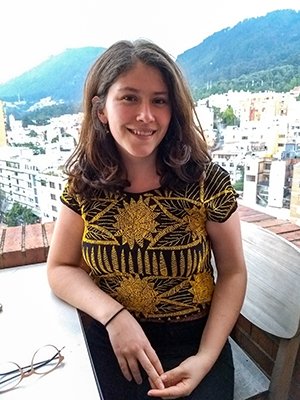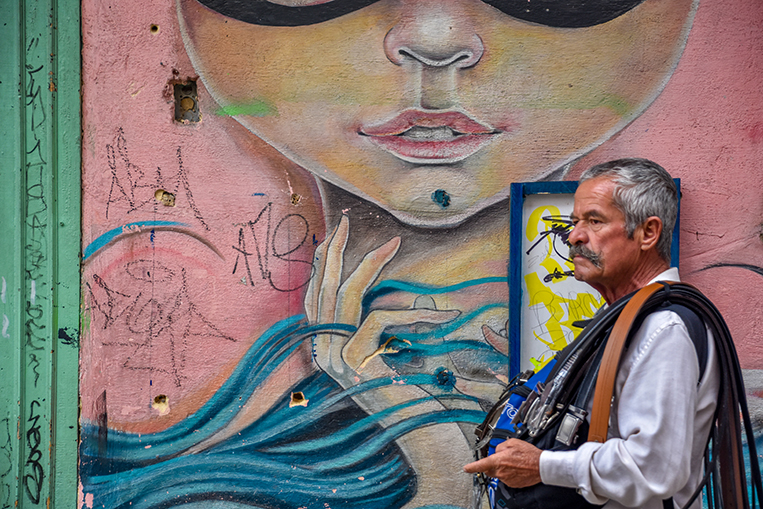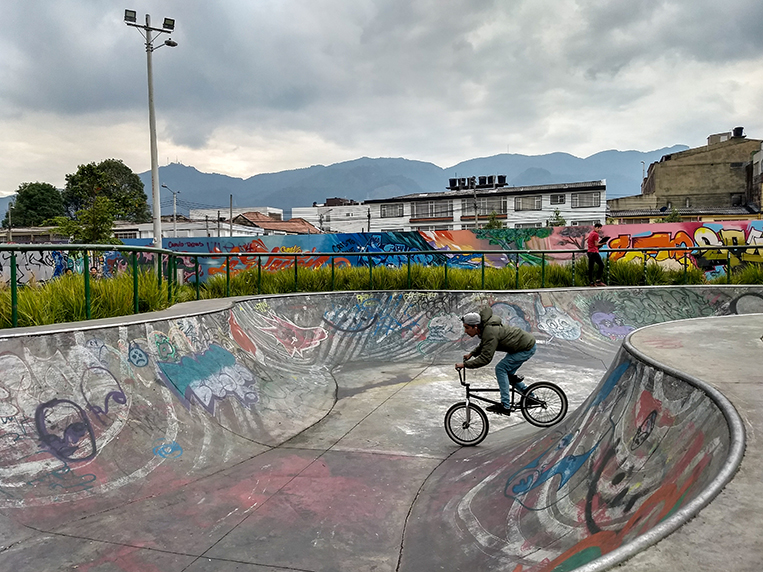Salomé Cohen Monroy greets me at the ground floor entrance to Laguna Libros, a small independent publishing house located in a simple, two-story brick building painted blue with its door flush onto the sidewalk. We are situated just east of the Universidad Nacional in the city center. The neighborhood here is composed of narrow blocks that were once residential and now appear to be populated by small companies. Cohen is twenty-five with auburn hair. She sports a pair of peach-colored, horn-rimmed glasses, wears a leopard-print blouse, bird earrings, and brick-colored Doc Martins with yellow laces. We ascend a narrow set of stairs to a conference table on a second floor landing between two offices.

Salomé Cohen Monroy
Cohen explains that the publishing house’s original plan was to sell inexpensive art books to students and less wealthy art fans. Rather than producing colorful but pricey coffee table books, they made smaller books in black-and-white. “It didn’t work,” she says. So they fell back on plan B: reprinting forgotten or overlooked books by Colombian authors. And they stumbled onto several hits. The first was Baranquilla 2132, a sort of Colombian 1984. Originally published in the 1930s by José Antonio Osorio Lizarazo, it sold well when they re-published it in 2011. Another success has been a collection of letters entitled Memoria por Correspondencia written by Emma Reyes, a Colombian artist and friend of Frida Kahlo, who was famous for her 1960s Parisian salon. The letters, addressed to the Colombian historian and journalist Germán Arciénagas, describe the artist’s horrific childhood.
“We started with a two-thousand-book print run, and in two weeks we needed more,” Cohen says. To date, they’ve sold twenty-three thousand copies. “Which is a lot for the Colombian market.”
After the book’s national success, Laguna Libros signed deals for translations in eighteen languages including a deal with Penguin Random House for an English edition with the author’s cut from the contract going to an orphanage stipulated by the deceased painter. That edition, entitled The Book of Emma Reyes, was released to acclaim in the United States by Penguin last October.
Cohen confesses that during high school she was “not especially into literature.” She read books about girls with eating disorders and other types of young adult literature. She grew up in Bogotá in an upper-middle-class family. Her mother had been a bohemian who moved in art circles, and when a teacher that Cohen’s mother respected opened a new school devoted to the arts in a new campus, she enrolled her three children. Cohen was the youngest.
The school, Gimnasio Fontana, was designed by the famed Colombian architect Rogelio Salmona. Active throughout the ’60s, ‘70s, and ‘80s, Salmona used red brick to construct buildings with warm organic spaces, curved facades, and public areas featuring trees and grasses. His buildings spawned imitation, and today large swaths of the northeastern Colombian enclaves of Bogotá feature smart, brick apartment complexes interwoven with shade trees and parks.
Not only did Cohen attend a school designed by the architect, but she currently resides in his most famous work, the Torres del Parque, a pair of residential towers that hover over the Bogotá bullring and the neighboring planetarium. Cohen’s friend, a journalist and magazine editor studying at Columbia University in New York City, has allowed Cohen the use of his apartment while he is away. The buildings rise in cylindrical towers with wings that unfurl like a toreador’s cape. Their presence has revitalized La Macarena, the residential neighborhood at their base, which is near the city center.
A strong student, Cohen attended the Universidad de los Andes. She began as a political science major, but halfway through her degree discovered that she was more enthralled with books and began taking literature courses. Upon graduating, she applied for jobs with publishing houses, found work manning a booth at the annual Bogotá book fair, then used the connections she made there to hop scotch to her current job with Laguna Libros. She’s been at the press for three years.
Cohen describes a local publishing industry dominated by two or three multinationals with limited avenues for new writers. There are no literary agents. “Well, one Colombian agent,” she says, “but she lives in New York.” When an author signs with Laguna Libros, the publisher splits any foreign publishing deals with the writer.
Since their start eleven years ago, the publishing house has established three distinct lines of books: overlooked Colombian books, literary fiction by contemporary authors from throughout Spanish America, and a line of graphic novels, sometimes originals and sometimes texts republished from other Spanish-speaking countries.
One successful book in their contemporary line takes place in the Chapinero neighborhood, a bohemian district favored by gay men. Cohen points out that there are many bookstores in the district, and the novel sells well there. One of the publisher’s graphic novels is Uncle Bill, originally published in Mexico, which details the day a drug-addled William Burroughs accidentally shot and killed his wife with a pistol (he was aiming for the glass she was balancing on her head).
During our interview, Felipe González, Cohen’s boss and the founder of Laguna Libros, a bearded man of thirty-four, steps out from his neighboring office and I ask him if Colombian publishers have faced government censorship or threats from the many previously warring parties in the country. González and Cohen smile at the question. There have been political assassinations of newspaper editors in the past, they say, but the various combatants in the country have tended to ignore literary publishers as inconsequential. Some bestselling authors, like Jorge Franco Ramos—whose novel Rosario Tijeras, which has sold more than two hundred thousand copies—have had to contend with pirate publishers selling cheap copies on the streets, but the pair say the pirates don’t waste their time stealing from smaller publishers.
Cohen oversees the line of contemporary novels. To date, she has published more women than men, she says, but she believes this to be unintentional. “It happened spontaneously,” she says. “The things we were getting from women were better than from men. Also if I get a manuscript that’s machista [chauvinist] then I don’t like it.”
At present, the publisher is also working in partnership with the Bogotá municipal government to organize a novel contest open to any Colombian woman writer. Submissions are read by men and women, both Colombian and international judges.
When Cohen isn’t reading submissions, editing books, and organizing contests, she is working on her own writing. She has written articles and book reviews for various online publications, including a story about Bogotá prostitutes and an opinion piece in protest of society’s insistence that women depilate. As part of her efforts to improve as a writer, she has signed up for several creative writing workshops.
A fairly recent phenomenon in Colombia, workshops in fiction, nonfiction, and poetry can be found across the city. Several book stores host eight-week seminars, held weekly and taught by established authors at a typical cost of $175. Creative writing classes are also offered by the municipal authority. These six-month workshops, which typically meet on Saturdays for four hours, are free but require an application and work sample; space is limited, so students must win admittance.
“People from all social provenances attend,” Cohen says of the workshops. The writing tends to be strong, and the classes have helped her improve her writing while also placing her in circles with talented emerging writers.
As our conversation winds down, I snap her photo with a borrowed camera, and she helps me call a taxi, but then she recalls an incident of a different kind of literary censorship. Offended by the contents of a book entitled El Tio (The Uncle) by Félix Marin, a powerful and wealthy family supposedly purchased every copy of the publisher’s print run and then had them burned.
“Every copy?” I ask.
“That’s the story,” she says.
It’s an interesting example, one that I can’t help but compare to the ways people in power work to censor art—and often entire communities—in the United States. Buying the entire print run effectively pays off the publisher and the writer, and enables one to legally squelch an embarrassing tell-all book. It’s censorship, but in capitalist, right-leaning countries, it’s the accepted kind.
The next evening, I return with some friends to meet Cohen at her apartment, which has a spectacular view of the city. She leads us down into the blocks along the hillside across the street from her home. I’ve been cautioned about wandering too deep into this neighborhood by myself, and Cohen agrees that it would not be wise for a foreigner to explore too far; however, the streets are lined with bars and restaurants. We step into Café Popular, where Cohen greets the manager and the bartender, who recommends a round of flaming gin-and-tonics. Cohen is delighted. She talks about the upcoming Bogotá book fair as we sip our drinks, and there is no need to ask her how she feels about the peace process or the prospects for her country; her opinion is evident in her enthusiasm. Clearly, she and other young people are ready to write the next chapter of Colombia’s story, one in which the guns have been refashioned as pens and celebrity chefs and mixologists have bumped the criminals and narcos off the stages of fame.
![]()
Here would be a nice place to end, but I have one final voice to introduce. Hector Abad is a sixty-year-old author from Medellín who was best known for his hyperrealist novels before he released his memoir, El Olvido que Seremos (Forgetting What We Will), published in the United States by Farrar, Straus and Giroux in 2006 as Oblivion: A Memoir. The book is a plaintive reflection upon his father’s murder. More than that, it is a Proustian examination of Abad’s childhood, his father’s love, and the author’s own encroaching death. In interviews and publicity photos, the author has gray hair, a neat gray beard, and glasses. During a guest appearance on the late Anthony Bourdain’s “Parts Unknown” on CNN, he displays a gentle good humor.
Abad is in Morocco on a literary tour when I visit Colombia, so we exchange questions and answers via e-mail. When I ask him if his country has changed since he published Oblivion, he points out that Medellín was once the most violent city in the world and that now it isn’t even on the list of the top fifty most violent cities. He points out that homicides in his hometown have fallen from 7,500 per year to under a thousand. “We were in hell,“ he writes, “now we are in purgatory.”
Abad says he is optimistic about the peace process, pointing out that in the last election cycle the political party representing the FARC, one of the former Marxist guerilla groups, participated in the voting and succeeded in winning a few Senate seats. Things appear to be changing.
I ask him how these changes have influenced his writing.
“Writing about violence was not normal or natural for me,” he responds. “If I did that, it was because violence came into my own home. I couldn’t avoid the argument.”
If I have learned anything from dipping into the literary world of Colombia, it is that violence entered people’s homes without knocking. There are more than fifty million Colombians. When I said at the beginning of this essay that there were no innocent parties in the Colombian civil wars, I was writing too quickly. I meant that among the various armed and warring parties, each shared some of the blame. What I neglected to mention was that the vast majority of Colombians were neither armed nor warring; the vast majority were not interested in war—they were innocent, and they were victims. The writers among them reflected these experiences in their plays, stories, and poems.
Now, as a country that for so long was defined by war emerges from that stretch of darkness, its writers and artists appear ready to turn the focus of their lives and their work toward anything else.
“Now I am working in subjects less political and much more personal,” Abad says. “Love, beauty, money, art, friendship, envy, greed, passion, natural death, big data, social media. The subjects we all are more interested in when murder is not around.”
Stephen Morison Jr. is a contributing editor of Poets & Writers Magazine. He has reported on the literary communities of Afghanistan, Albania, China, Denmark, Egypt, Jordan, Myanmar, Rome, Vietnam, North Korea, and Syria. He currently lives in Maine.









